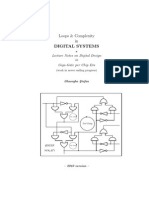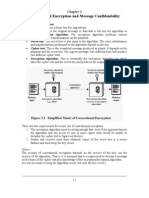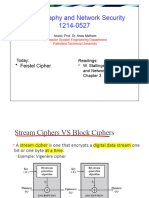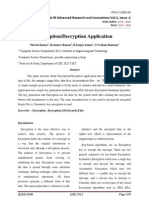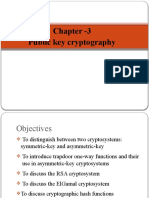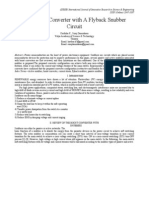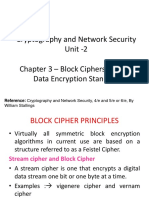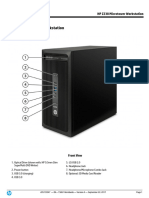Image Encryption Using Hyper Chaos and Symmetric Cryptography
Uploaded by
mishranamit2211Image Encryption Using Hyper Chaos and Symmetric Cryptography
Uploaded by
mishranamit2211(IJIRSE) International Journal of Innovative Research in Science & Engineering
ISSN (Online) 2347-3207
Image Encryption Using Hyper Chaos and
Symmetric Cryptography
Mozhgan Mokhtai*, Meghdad Ashtiyani
#
, Hassan Naraghi**
Department of Mathematics, Ashtian Branch,Islamic Azad University, Ashtian, Iran
*,**
Tehran University of Medical Science, International Campus (TUMS-IC) Tehran, Iran
#
mozhganmokhtari@yahoo.com*, naraghi@aiau.ac.ir**, m-ashtiyani@razi.tums.ac.ir
#
Abstract In recent years, a large amount of work on chaos-based cryptosystems has been published.
However, most of them encounter some problems such as low level of security and small key space. The
key stream generator is the key design issue of an encryption system. In this paper a new approach to
image encryption based on hyper chaotic map is proposed in order to meet the requirements of the secure
image transfer. In the proposed encryption scheme, 4D hyper-chaotic system is used in key scheming, this
encryption scheme is also based on combination of scrambling and confusion. Chaotic cat map is used for
the scrambling the addresses of the image pixels. In order to provide security for the scheme, a modified
form of Simplified version of Advance Encryption Standard (S-AES) is applied. The modification is that
we make use of chaos for S-box design and replace it with that of S-AES. The so called Chaotic S-AES has
all cryptographic characteristics and requirements of S-AES. Hence, the main contribution of this work is
that we make use of chaos in both image diffusion and confusion parts. In order to check the performance
of the method, experimental implementation has been done. It worth be noting that the resistance of the
scheme against differential and linear cryptanalysis is at least as of S-AES [3,4].
Keywords-hyper chaos; cat map; cryptography; Advance Encryption Standard (AES);
I. INTRODUCTION
Nowadays human beings need to communicate more than ever. At present, secure communication plays an
increasing and ever-growing role in many fields of common life, such as banking, commerce,
telecommunication, networking and so on. Some communications must be reliable and have the best security as
possible as they can. There are many different methods for communication in security like cryptography.
Over the past decade, there has been tremendous interest in studying the behavior of chaotic systems.
Chaotic functions are blessed with properties like sensitivity to the initial condition, and ergodicity which make
them very desirable for cryptography [1]. The close relationship between chaos and cryptography makes chaos
based cryptographic algorithms as a natural candidate for secure communication and cryptography chaos based
encryption techniques are considered good for practical use as these techniques provide a good combination of
speed, high security, complexity, reasonable computational overheads and computational power, etc.
Unlike the conventional cryptographic algorithms which are mainly based on discrete mathematics, chaos-
based cryptography is relied on the complex dynamics of nonlinear systems or maps which are deterministic but
simple. Therefore, it can provide a fast and secure means for data protection, which is crucial for data
transmission over fast communication channels, such as the broadband internet communication [2].
The chaos based cryptographic algorithms have suggested some new and efficient ways to develop secure
data encryption techniques. Towards this direction, we design an efficient chaos based symmetric cryptography
system for image encryption. In this paper we use symmetric cryptography and chaos for encrypt images.
Symmetric cryptography algorithm that we used in this project is Advanced Encryption Standard (AES) [3, 4].
II. CRYPTOGRAPHY AND CHAOS
The chaos is a process of definite pseudo-random sequence produced by nonlinear dynamics system. Its
non-periodic and non-astringe. Chaos functions have mainly used to develop mathematical models of non linear
systems. They have attracted the attention of many mathematicians owing to their extremely sensitive nature to
initial conditions and their immense applicability to modeling complex problems of daily life. Chaotic functions
which were first studied in the 1960's show numerous interesting properties. The iterative values generated from
such functions are completely random in nature, although limited between bounds. The most fascinating aspect
of these functions is their extreme sensitiveness to initial conditions. For example even if the initial start value of
iterations is subjected to a disturbance as small as 10
-100
, iterative values generated after some number of
iterations are completely different from each other. This extreme sensitivity to the initial conditions makes
chaotic functions very important for application in cryptography.
The chaos-based encryption was first proposed in 1989 [11], since then, many researchers have proposed
and analyzed a lot of chaos-based encryption algorithms, these work all have been motivated by the chaotic
(IJIRSE) International Journal of Innovative Research in Science & Engineering
ISSN (Online) 2347-3207
properties such as the sensitive dependence on initial conditions and system parameters, pseudorandom
property, non-periodicity and topological transitivity, etc.[9]
The characteristics of the chaotic maps have attracted the attention since it has many fundamental properties
such as ergodicity, sensitivity to initial condition, system parameter, mixing property, etc. Most properties are
related to some requirements such as mixing and diffusion in the sense of cryptography.
Recently, in [13], a fast chaotic cryptographic scheme based on iterating a Logistic map was proposed, and
no random numbers need to be generated and the look-up table used in the cryptographic process is updated
dynamically. In [14], a 2D chaotic cat map is generalized to 3D for designing a real-time secure symmetric
encryption scheme, which employs the 3D cat map to confuse the relationship between the cipher-image and the
plain-image. To overcome the drawbacks such as small key space and weak security of one-dimensional chaotic
map, a nonlinear chaos algorithm is proposed in [18], which shows high-level security and acceptable
efficiency. Recently, because hyper-chaos has more than one positive Lyapunov exponent, and have more
complex dynamical characteristics than chaos, so secure communication schemes based on hyper-chaotic
systems have been investigated [20], but at present, there is little work about the study of encryption algorithm
based on hyper-chaos. In general, as the prediction time of a chaotic system is longer than that of a hyper-
chaotic system [21], so it may be more valuable to study the application of hyper-chaos in encryption
algorithms[9]
III. PROPOSED ALGORITHM
Our proposed scheme for image encryption consists of two processes, namely scrambling and encryption.
Firstly, we scramble the image based on total image scrambling matrix generated by using 2D chaotic map, and
then encrypt the scrambled image by using hyper chaos. Both of processes use chaos for design process as we
will explain hereafter. Figure 1 illustrates the block diagram of our algorithm. The scrambling block, which
provides confusion for our scheme, is in essential a chaotic map [3].
Each chaotic mapping is a set of differential equations which often design to represent an unpredictable
phenomenon of the environment. Parameters of the mapping, i.e. differential or difference equations should be
chosen so that the outputs of the system have an adequate level of unpredictability. Any chaotic mapping which
attains required level of security can be used here.
Our approach differs with all previous works in the sense that we use chaos to provide both diffusion and
confusion [4].
Figure 1. Block diagram of this project
As depicted, the image pixels first scrambled via Cat Map chaotic mapping. Then the second stage provides
diffusion for pixels values modification in the image by applying S-AES algorithm (with chaotic S-box) to every
pixel. As it was also shown in [7], combining cat map with block cipher system can provides additional features
for the system. We will explain these two sub blocks of scheme in following.
IV. IMAGE SCRAMBLING
In this project for advancing the quality of encryption effectively, we have used pixel position scrambling
method before encryption. This stage is called confusion stage that permutes the pixels in the image without
changing its values by applying scrambling algorithm.
Some classical scrambling algorithms are cat map [6], knight-tour transformation [12], affine transformation
[11], standard map, tent map etc. Among these maps, baker map and cat map attract much attention. Cat map is
a two-dimensional chaotic map introduced by Arnold and Avez [35]. Baker map is another 2D chaotic map
based on which Pichler and Scharingfirst introduced their encryption schemes. The 2-D chaotic cat map was
generalized to 3-D for designing a real-time secure symmetric encryption scheme, which employed 3-D cat map
to shuffle the positions of image pixels and used another chaotic map to confuse the relationship between the
cipher-image and the plain-image. In [13], baker map was further extended to 3-D. An alternative chaotic image
encryption based on baker map that supports a variable-size image and includes other functions such as
password binding and pixel shifting to further strengthen the security of the cipher-image was proposed [31]. In
[15], Baptista proposed a chaotic encryption based on partitioning the visiting interval of chaotic orbits of the
logistic map. In this project we apply cat map for scrambling of image [3].
(IJIRSE) International Journal of Innovative Research in Science & Engineering
ISSN (Online) 2347-3207
A. Image scrambling using cat map
Image data has strong correlations among adjacent pixels. In order to disturb the high correlation among
pixels, an image total scrambling matrix is used to scramble the position of the plain image. Without loss of
generality, we assume that the dimension of the plain image is N M, the position matrix of pixels is ) (
,
I P
n n
y x
,
{ ; 1 .., , 2 , 1 , 0 e N x
n
, { ; 1 .., , 2 , 1 , 0 e M y
n
, where ) (
,
I P
n n
y x
is the grey value of the image.
Cat mapping is from Arnold, and it is named because of demonstrating it with a cats face usually, the
classical Arnold cat map is a two-dimensional map [7] described by:
) mod( .
1
1
1
1
N
y
x
ab b
a
y
x
n
n
n
n
(
+
=
(
+
+
(1)
where
) , (
n n
y x
is the pixel position in the N M image so that :
{ ; 1 .., , 2 , 1 , 0 e N x
n
(2)
{ ; 1 .., , 2 , 1 , 0 e M y
n
and
) , (
1 1 + + n n
y x
is the transformed position after cat map; a and b are two control parameters and are positive
integers. Cat map has two typical factors, which bring chaotic movement: tension (multiply matrix in order to
enlarge x, y) and fold (taking mod in order to bring x, y in unit matrix). In fact, cat map is a chaotic map. Image
position is scrambled via the iteration of cat map, consequently realizing the image encryption. The result of
scrambling is different for difference of the iteration times. For a 256 256gray image, it is hard to find out the
trace of original image after iterating 30 times, reaching the effect of scrambling; the image after iterating 64
times is the same as the original image, so cat map has the periodicity. With the differences of the parameter and
the images size, the periodicity is different. Image can be scrambled via keeping the value of a and b secret,
but the periodicity will bring some insecure factors, so applying cat map solely cannot meet the demands of
encryption; and cat map only transforms the original images position, however the pixels values have not been
changed [4].
I. CHAOTIC AES
The next, but somehow more important part of our proposed scheme is encryption part. Since high speed for
encryption/decryption is a feature of interest in online secure image transmission, we have to apply
encryption/decryption scheme which has satisfactory speed in practical implementation.
Besides security level of this block is of great importance as diffusion of the image information is provided
with this block. Many renowned block ciphers, such as DES, AES, MISTY etc, can be used based on required
level of security, size of the key, speed of implementation and other related design metrics. Some previous
works, such as [34], are of this family. That is they utilize block ciphers in conjunction with scrambling for
image encryption. It applies cat map for scrambling of pixel contents and simplified AES for encryption. Our
approach differs with previous works in the sense that we use chaos to provide both diffusion and confusion.
That is, we also make use of chaos in encryption process by utilizing it in S-box design procedure [3, 4].
Here, we briefly overview chaotic S-box design. Security of block ciphers mainly relies on the S-boxes,
since they are the only nonlinear element in block cipher algorithm. So designing S-boxes to maintain
cryptographic requirements is actually the heart of block cipher design. S-box design criterion of the most
famous block cipher, DES, have been mysterious for decades, after its adaptation as a federal standard in 1977
and have not been published till now. On the other hand, new block cipher designers often clarify their assumed
criterion for picking up an S-box. For, S-box of AES, new selected block cipher in replacement of DES has been
chosen mathematically. Due to lack of space, we cannot review this subject anymore and just comes up to our
used scheme. Some papers employ chaos for S-box design. We use the presented approach in [32] and produce
chaotic-based S-box for S-AES. S-AES is simplified version of AES algorithm [33]. It operates on 16-bit
plaintexts and generates 16-bit cipher texts, using the expanded key k
0
,.., k
47
.
For more information about S-AES, we recommend taking a look at [33]. In order to produce an S-box with
chaos, it is necessary to choose a chaotic mapping with good level of unpredictability and irregularity. Then one
of the outputs should be selected, quantized and sampled. Numbers of quantization levels are equal to the S-box
size. We make use of hyper-chaotic mapping [18], in the procedure of S-box design
The first and most necessary characteristic to check is that the obtained S-box should be reversible. The
other essential cryptographic characteristics and requirements for obtaining good S-box have been check and S-
box with satisfactory level of them has been chosen. It must be noted that some parameters of the chaotic
(IJIRSE) International Journal of Innovative Research in Science & Engineering
ISSN (Online) 2347-3207
mapping and sampling rate should be tuned well in order to reach acceptable S-box. This S-box then replaced
with the S-box of S-AES to attain chaos-based block cipher, which we name it chaotic-S-AES hereafter. That
the chaos is also used in the design of encryption algorithm is the main prominence of our work in comparison
with the formers [3, 4].
II. HYPER CHAOTIC KEY SPACE
While classical encryption algorithms are sensitive to keys, so some elaborated constructions are need to
achieve satisfying and safer chaos-based encryption. It is well known that a good encryption algorithm should
be sensitive to the cipher keys, and the key space should be large enough to make brute-force attacks infeasible
[12].
The difference between hyper-chaos and chaos is that the further is unstable in at least two directions, while
the latter only diffuses in one certain direction. In other words, the hyper-chaos has at least two positive
Lyapunov exponents, while the latter has only one. For security, because hyper chaotic systems have more
complicated phase space than chaotic systems, it is difficult to use those methods based on chaos
synchronization to attack them [9].
Compared with one-dimensional chaotic map, for example, logistic mp and skew tent map, 4D hyper chaotic
system defined as (1) has more control parameters and initial conditions. It can enlarge the key space when it is
combined in the image encryption algorithm.
In the proposed encryption scheme, this 4D hyper-chaotic system generated from Chens chaotic system [30] is
used in key scheming, which is modeled by:
+ = '
= '
+ + = '
= '
k x w
dz xy z
w cy bx xz y
x y a x ) (
(3)
Where when a = 36, b = 16, c = 28, d = 3, and k [0.7, 0.7], the system can be in chaos phenomena (Figure
2, 3 and 4), and its Lyapunov exponents are
54 . 10 , 0 , 019 . 0 , 499 . 1
4 3 2 1
= = = =
. More details can be seen
and studied in [5] with some other properties.
With randomly chosen initial conditions
0 0 0
, , z y x and
0
w , if the system (1) is iterated after many rounds, we
can get a chaotic sequence { ; ,... , , , , , , ,
1 1 1 1 0 0 0 0
w z y x w z y x s = .
This chaotic system selects four control parameters for the key, four initial values change with encryption
process, so the key space is large enough. We can divide image into many sections, and each section is
encrypted with a different key, the key is produced through four dimensional map and AES algorithm, and it is
more secure. Due to the randomness of four-dimensional map and the security of AES, it is hard to get internal
control parameters even if someone knows the key generator. The probability of obtaining the encryption keys is
very low [9].
As the hyper-chaos has two positive Lyapunov exponents, so the prediction time of a hyper chaotic system is
shorter than that of a chaotic system [21], as a result, it is safer than chaos in security algorithm. For more
detailed analysis of the complex dynamics of the system, please see relative references [30, 9].
Figure 2. Hyper chotic system (y-x plane) Figure 3. Hyper chotic system (z-y plane) Figure 4. Hyper chotic system (w-x plane)
(IJIRSE) International Journal of Innovative Research in Science & Engineering
ISSN (Online) 2347-3207
V. EXPRIMENTAL RESULT
A. Correlation Analysis
To test the correlation between two adjacent pixels (vertically and horizontally) in an encrypted image, some
simulations are carried out. Firstly, randomly select 4096 pairs of two adjacent pixels from the image, then
calculate the correlation coefficient of each pair by using the following formulas [14]:
=
=
n
i
i
x
N
x E
1
1
) (
(4)
=
=
n
i
i i
x E x
N
x D
1
2
)) ( (
1
) (
(5)
=
=
n
i
i i i i
y E y x E x
N
y x
1
)) ( ))( ( (
1
) , cov(
(6)
) ( ) (
) , cov(
Y D x D
y x
r
xy
=
(7)
where x and y are grey values of two adjacent pixels in the image. From Table I, it can be seen that the proposed
image encryption algorithm based on image total shuffling matrix have better performance compared with
algorithm proposed by Ref. [18], which used the same grey image as that in this Letter. In the meantime, as
hyper-chaos has larger key spaces than that of chaos used in some literatures [2,3,20], and the image shuffling
algorithm proposed here is more secure than that using Arnold cat map transformation, which is periodic [3], so
hyper-chaos has some potential application in image encryption algorithms.
TABLE I. CORRELATION OF TWO ADJACENT PIXELS
Original image Encrypted image
Horizontal 0.9842 0.0098
Vertical 0.9762 0.0003
B. Histogram
The Lena image of size 512512 and 256 gray levels is employed for experimentation. The original image is
shown in figure 5, its histogram is given in figure 8. Figure 6 is the image obtained after confusion process on
the plain image. The corresponding histogram is shown in figure 9. It was observed from figure 8 and figure 9
that both histograms are same. It means that the corresponding statistical information depicted in Fig.6 after
confusion process is exactly the same as that of the original image. It is due to the fact that cat map does not
change the pixel values of the Lena image. The result shown in figure 7 is encrypted image obtained after
chaotic S-AES process. The corresponding histogram is shown in Fig.10. From the figure, one can see that the
histogram of the ciphered image is fairly uniform and is significantly different from that of the original image.
It was observed that this histogram is entirely different from one shown in figure 8.
Figure 5. Original image Figure 6. Scrambled image Figure 7. Encrypted image
Figure 8. Histogram of original image Figure 9. Histogram of scrambled image Figure 10. Histogram of encrypted image
(IJIRSE) International Journal of Innovative Research in Science & Engineering
ISSN (Online) 2347-3207
C. Key Space Analysis
In our algorithm, the initial values of Logistic map and hyper-chaotic system are used as secret keys, if the
precision is
14
10
, the key space size is
70
10 . Also, the initial iteration number N0 and k can also be used as the
secret keys. This is enough to resist all kinds of brute-force attacks. It can be shown that hyper-chaos encryption
algorithm is sensitive to the key; a small change of the key will generate a completely different decryption result
and cannot get the correct plain-image.
D. Security Analysis
A good encryption should resist all kinds of known attacks, it should be sensitive to the secret keys, and the
key space should be large enough to make brute-force attacks infeasible. Some security analysis has been
performed on the proposed image encryption scheme, the resistance of the scheme against differential and linear
cryptanalysis is at least as of S-AES.
VI. CONCLUSION
In this paper, an image encryption scheme based on the combination of chaotic map for the scrambling the
addresses of the pixels and chaotic simplified AES for the encryption is proposed to achieve adequate level of
security for image transmission. Efficiency of the scheme has been confirmed through experimental tests. The
main advantage of our approach is that we make use of chaos in both scrambling and encryption procedure. As a
result, our proposed algorithm differs with previous works in the sense that we use chaos to provide both
diffusion and confusion. That is, we also make use of chaos in encryption process by utilizing it in S-box design
procedure. It worth be noting that the resistance of the scheme against differential and linear cryptanalysis is at
least as of S-AES.
ACKNOWLEDGMENT
The authors acknowledge helpful comments provided by the anonymous reviewers. We benefited from
advices by Dr. M. Bagheri, Dr. S. S. Karimi Madahi, Dr. Jalil. Ghahramani, Dr. Hossein Sarabadani and critical
readings by Dr. P.M. Birgani and Dr. Meysam Siyahmansoori. The authors are grateful to Tehran University of
Medical Science, International Campus (TUMS-IC) and Islamic Azad University, Ashtian branch.
REFERENCES
[1] Bose, R. and Banerjee, A., Implementing Symmetric Cryptography Using Chaos Functions, Advanced Computing &
Communication Conference, 1999.
[2] H.S. Kwok, Wallace K.S. Tang. " A fast image encryption system based on chaotic maps with finite precision representation", Chaos,
Solitons and Fractals 32 (2007) 15181529
[3] M. Ashtiyani, P. Moradi Birgani , S. S. Karimi Madahi, Speech Signal Encryption Using Chaotic Symmetric Cryptography, J.
Basic. Appl. Sci. Res., 2(2)1678-1684, 2012
[4] M.ashtiyani, P.Moradi Birgani and Hesam M . Hosseini Chaos-Based Medical Image Encryption Using Symmetric Cryptography ,
ICTTA Conference 2008.
[5] Lizhen CHEN, A Novel Image Encryption Scheme Based on Hyperchaotic Sequences Journal of Computational Information
Systems 8: 10 (2012) 4159-4167
[6] G.R. Chen and Y.B. Mao et al., A symmetric image encryption scheme based on 3D chaotic cat maps, Chaos, Solitons & Fractals
21, pp. 7497612, (2004).
[7] Kh. S. Singh, S. Devi and S. S. Singh, Encryption Scheme based on Combination of Cat Map and SDES, DOEACC Center, Imphal.
[8] Mina Mishra and V. H. MankarReview on Chaotic Sequences Based Cryptography and Cryptanalysis, nternational Journal of
Electronics Engineering, 3 (2), 2011, pp. 189194
[9] Tiegang Gao and Zengqiang ChenA new image encryption algorithm based on hyper-chaos, Physics Letters A 372 (2008) 394400
[10] Mayank Mishra, Prashant Singh, Chinmay Garg, A New Algorithm of Encryption and Decryption of Images Using Chaotic
Mapping, International Journal of Information & Computation Technology.ISSN 0974-2239 Volume 4, Number 7 (2014), pp. 741-
746
[11] R. Matthews, On the derivation of a chaotic encryption algorithm,Cryptologia 8 (1989) 29.
[12] B. Schneier, Applied Cryptography: Protocols, Algorithms, and Source Code in C, second ed., Wiley, New York, 1995
[13] K.W. Wong, A fast chaotic cryptographic scheme with dynamic look-up table, Phys. Lett. A 298 (2002) 238.
[14] G. Chen, Y.B. Mao, C.K. Chui, A symmetric image encryption scheme based on 3D chaotic cat maps,Choas Solitons Fractals 21
(2004) 749.
[15] M.S. Baptista, Cryptography with Chaos, Phys. Letters, A, 240 (1-2), (1998).
[16] Birgani P M and Ashtiyani M, Wireless real time Brain mapping, Biomed 06, IFMBE Proceeding, pp. 444-446.
[17] Salim M. Wadi and Nasharuddin ZainalRapid Encryption Method based on AES Algorithm for Grey Scale HD Image Encryption,
4th International Conference on Electrical Engineering and Informatics, ICEEI 2013.
[18] XIAO Yong-Liang and XIA Li-Min, An Image Encryption Approach Using a Shuffling Map, Theor. Phys. (Beijing, China) 52
(2009) pp. 876880.
[19] Meghdad Ashtiyani, Saeed Asadi, Pedram Hassani Goudarzi, A New Method in Transmitting Encrypted Data by FCM Algorithm,
Second IEEE international conference on information and communication from theory to application, Syria 2006.
(IJIRSE) International Journal of Innovative Research in Science & Engineering
ISSN (Online) 2347-3207
[20] J.P. Goedgebuer, L. Larger, H. Port, Optical cryptosystem based on synchronization of hyperchaos generated by a delayed feedback
tunable laser diode ,Phys. Rev. Lett. 80 (1998) 2249.
[21] S. Yanchuk, T. Kapitaniak, Symmetry-increasing bifurcation as a predictor of a chaos-hyperchaos transition in coupled
systems,Phys. Rev. E 64 (2001) 056235.
[22] Meghdad Ashtiyani, Parmida Moradi Birgani and Saeed Asadi MRI Segmentation Using Fuzzy C-means Clustering a Algorithm
Basis Neural Network ICTTA Conference 2008.
[23] Meghdad Ashtiyani, soroor behbahani, Saeed Asadi and Parmida Moradi Birgani, Transmitting Encrypted Data by Wavelet
Transform and Neural Networks Signal Processing and Information Technology, 2007 IEEE International conference.
[24] MS Mansoory, M Ashtiyani, TN Hojjat Cardiac motion evaluation for disease diagnosis using ICA basis neural network, Computer
Science and Information Technology-Spring Conference, 2009.
[25] MS Mansoory, M Ashtiyani, H SarabadaniAutomatic Crack Detection in Eggshell Based on SUSAN Edge Detector Using Fuzzy
Thresholding Modern Applied Science 5 (6), p117
[26] SS Karimi Madahi and P. Salah,A Neural Network Based Method for Cost Estimation 63/20kV and 132/20kV Transformers Journal
of Basic and Applied Scientific Research, 2012.
[27] Jalil Ghahramani and Seyed Siavash Karimi MadahiAdjusting the Transient Stability of Power System Using STATCOM-SMES
Combined Compensator Applied Mechanics and Materials, p.1115-1119, 2012
[28] SS Karimi Madahi, M HassaniOptimal design of insulators of using Artificial Neural Network (ANN) Journal of Basic and Applied
Scientific Research 2 (1), 2012.
[29] Meghdad Ashtiyani, Saeed Asadi and Parmida Moradi Birgani, ICA-Based EEG Classification Using Fuzzy C-mean Algorithm,
ICTTA Conference 2008.
[30] T.G. Gao, Z.Q. Chen, Z.Y. Yuan, G. Chen, Hyperchaos generated from Chen's system, Int. J. Mod. Phys. C 17 (2006)471
[31] G.Jakimoski and L. Kocarev, Chaos and Cryptography: Block Encryption Ciphers based on Chaotic Maps, IEEE Trans. on Circuits
and Systems1, fundam. Theory Applic. vol. 48, no. 2, pp. 163-169, Feb. (2001)
[32] P. Amani, H. Khalozadeh, and M. R. Aref, S-box design for AES block cipher with chaotic mapping, inProceeding of 4th Iranian
Society of Cryptology Conference(ISCC07), Tehran, Iran, 16-18 Oct, pp.91-98, (2007).
[33] Musa, E. Schaefer, and S. Wedig, A simplified AES algorithm and its linear and differential cryptanalyses, inCryptologia 27,
p.148177, April (2003)
[34] Kh. S. Singh, S. Devi and S. S. Singh, Encryption Scheme based on Combination of Cat Map and SDES,DOEACC Center, Imphal.
[35] http://mathworld.woffram.com/arnoldsCatMap.html
[36] www.mathworks.com
You might also like
- Image Encryption - A Communication PerspectiveNo ratings yetImage Encryption - A Communication Perspective406 pages
- CS 25000 Spring 2017 Final Practice SolutionsNo ratings yetCS 25000 Spring 2017 Final Practice Solutions13 pages
- Innovations in Portland Cement Manufacturing80% (5)Innovations in Portland Cement Manufacturing1,283 pages
- Simulation of Image Encryption Using AES AlgorithmNo ratings yetSimulation of Image Encryption Using AES Algorithm8 pages
- Information Systems Security LAB: RSA Cryptography AlgorithmNo ratings yetInformation Systems Security LAB: RSA Cryptography Algorithm9 pages
- Landmasses and Bodies of Water Surrounding The Philippines100% (2)Landmasses and Bodies of Water Surrounding The Philippines18 pages
- Medical Image Encryption Using Multi Chaotic MapsNo ratings yetMedical Image Encryption Using Multi Chaotic Maps10 pages
- Paper 1-Encryption Algorithms For Color Images PDFNo ratings yetPaper 1-Encryption Algorithms For Color Images PDF11 pages
- A Project On Digital Watermarking Using MatlabNo ratings yetA Project On Digital Watermarking Using Matlab24 pages
- Image Encryption and Decryption Using Symmetric Key in MatlabNo ratings yetImage Encryption and Decryption Using Symmetric Key in Matlab4 pages
- Enhanced Arnolds Cat Map-AES Encryption Technique For Medical ImagesNo ratings yetEnhanced Arnolds Cat Map-AES Encryption Technique For Medical Images8 pages
- Automatic Water Level Control and Monito PDFNo ratings yetAutomatic Water Level Control and Monito PDF5 pages
- Aes Algorithm For Encryption: Radhika D.BajajNo ratings yetAes Algorithm For Encryption: Radhika D.Bajaj6 pages
- Hybrid Robust Watermarking Technique Based On DWT, DCT and SVDNo ratings yetHybrid Robust Watermarking Technique Based On DWT, DCT and SVD7 pages
- Implementation of Aes and Blowfish AlgorithmNo ratings yetImplementation of Aes and Blowfish Algorithm4 pages
- Block Cipher: The Advanced Encryption Standard (AES)No ratings yetBlock Cipher: The Advanced Encryption Standard (AES)8 pages
- 02 - Chapter 2 - Conventional Encryption and Message ConfidentialityNo ratings yet02 - Chapter 2 - Conventional Encryption and Message Confidentiality16 pages
- " Image Encryption Using AES ": End Semester Project Report OnNo ratings yet" Image Encryption Using AES ": End Semester Project Report On18 pages
- Implementation of Blowfish Algorithm in Image Encryption and DecryptionNo ratings yetImplementation of Blowfish Algorithm in Image Encryption and Decryption14 pages
- Design and Analysis of Cryptographic Algrithm100% (1)Design and Analysis of Cryptographic Algrithm273 pages
- ECE428 Xilinx ISE Tutorial: Haibo Wang Southern Illinois University Carbondale100% (1)ECE428 Xilinx ISE Tutorial: Haibo Wang Southern Illinois University Carbondale10 pages
- Image Based Stegnography Using LSB Technique0% (1)Image Based Stegnography Using LSB Technique62 pages
- Image Steganography Project by Ajit Kumar Satapathy100% (4)Image Steganography Project by Ajit Kumar Satapathy32 pages
- Digital Logic HW #2 (Chapter 2) : (A) Xy + Xy' (B) (X + Y) (X + Y') (C) Xyz + X'y + Xyz' (D) (A + B) ' (A' + B') 'No ratings yetDigital Logic HW #2 (Chapter 2) : (A) Xy + Xy' (B) (X + Y) (X + Y') (C) Xyz + X'y + Xyz' (D) (A + B) ' (A' + B') '2 pages
- IIR Digital Filtyttyer Structures Filter DesignNo ratings yetIIR Digital Filtyttyer Structures Filter Design35 pages
- William Stallings, Cryptography and Network Security 6 - e (PDFDrive)No ratings yetWilliam Stallings, Cryptography and Network Security 6 - e (PDFDrive)65 pages
- T318 Applied Network Security: Dr. Mahmoud AttalahNo ratings yetT318 Applied Network Security: Dr. Mahmoud Attalah54 pages
- Digital Logic Design: Assignment 1 Due Date: 10.12.2020 (Thursday)No ratings yetDigital Logic Design: Assignment 1 Due Date: 10.12.2020 (Thursday)3 pages
- Echo on a Chip - Secure Embedded Systems in Cryptography: A New Perception for the Next Generation of Micro-Controllers handling Encryption for Mobile MessagingFrom EverandEcho on a Chip - Secure Embedded Systems in Cryptography: A New Perception for the Next Generation of Micro-Controllers handling Encryption for Mobile MessagingNo ratings yet
- A Comparative Study of Classification Methods in Data Mining Using RapidMiner Studio100% (1)A Comparative Study of Classification Methods in Data Mining Using RapidMiner Studio6 pages
- Road Landslide Stabilization by Using Hutchinson's MethodNo ratings yetRoad Landslide Stabilization by Using Hutchinson's Method8 pages
- Use of Endothelin-1 (ET-1) and Von Willenbrand Factor (VWF) As Biological Markers in Patients With Normo and Micro AlbuminuriaNo ratings yetUse of Endothelin-1 (ET-1) and Von Willenbrand Factor (VWF) As Biological Markers in Patients With Normo and Micro Albuminuria6 pages
- ZVS Boost Converter With A Flyback Snubber CircuitNo ratings yetZVS Boost Converter With A Flyback Snubber Circuit8 pages
- Applying Computer Aided Designing For Steam Turbine Blade100% (1)Applying Computer Aided Designing For Steam Turbine Blade6 pages
- Spatial Distribution of Non-Point Source Pollution in Vembanad LakeNo ratings yetSpatial Distribution of Non-Point Source Pollution in Vembanad Lake6 pages
- An Empirical Study of MSMEs of Bamboo Made Home Appliances in Eastern UPNo ratings yetAn Empirical Study of MSMEs of Bamboo Made Home Appliances in Eastern UP7 pages
- Analysis of Stress in Anchorage Zone Using AnsysNo ratings yetAnalysis of Stress in Anchorage Zone Using Ansys5 pages
- Teenage Pregnancy Factors On Completion Rate of Female Students in Public Secondary Schools in Nyamasheke District RwandaNo ratings yetTeenage Pregnancy Factors On Completion Rate of Female Students in Public Secondary Schools in Nyamasheke District Rwanda18 pages
- Overview of Mergers and Acquisition and MNo ratings yetOverview of Mergers and Acquisition and M11 pages
- Cryptography and Network Security Unit - 2 Chapter 3 - Block Ciphers and The Data Encryption StandardNo ratings yetCryptography and Network Security Unit - 2 Chapter 3 - Block Ciphers and The Data Encryption Standard86 pages
- Junior Assistant in Telangana State Road Transport CorporationNo ratings yetJunior Assistant in Telangana State Road Transport Corporation23 pages
- Electric-Fusion-Welded Steel Pipe For Atmospheric and Lower TemperaturesNo ratings yetElectric-Fusion-Welded Steel Pipe For Atmospheric and Lower Temperatures7 pages
- J Institute Brewing - January February 1993 - Langstaff - The MOUTHFEEL of BEER A REVIEWNo ratings yetJ Institute Brewing - January February 1993 - Langstaff - The MOUTHFEEL of BEER A REVIEW7 pages
- The Visible Light Quiz Google Forms PRINTEDNo ratings yetThe Visible Light Quiz Google Forms PRINTED4 pages
- Sl. No. Institution Code Institution Name: Public Sector BanksNo ratings yetSl. No. Institution Code Institution Name: Public Sector Banks21 pages
- How To Become Millionare in 5 Years or LessNo ratings yetHow To Become Millionare in 5 Years or Less5 pages
- Simulation of Image Encryption Using AES AlgorithmSimulation of Image Encryption Using AES Algorithm
- Information Systems Security LAB: RSA Cryptography AlgorithmInformation Systems Security LAB: RSA Cryptography Algorithm
- Landmasses and Bodies of Water Surrounding The PhilippinesLandmasses and Bodies of Water Surrounding The Philippines
- Paper 1-Encryption Algorithms For Color Images PDFPaper 1-Encryption Algorithms For Color Images PDF
- Image Encryption and Decryption Using Symmetric Key in MatlabImage Encryption and Decryption Using Symmetric Key in Matlab
- Enhanced Arnolds Cat Map-AES Encryption Technique For Medical ImagesEnhanced Arnolds Cat Map-AES Encryption Technique For Medical Images
- Hybrid Robust Watermarking Technique Based On DWT, DCT and SVDHybrid Robust Watermarking Technique Based On DWT, DCT and SVD
- Block Cipher: The Advanced Encryption Standard (AES)Block Cipher: The Advanced Encryption Standard (AES)
- 02 - Chapter 2 - Conventional Encryption and Message Confidentiality02 - Chapter 2 - Conventional Encryption and Message Confidentiality
- " Image Encryption Using AES ": End Semester Project Report On" Image Encryption Using AES ": End Semester Project Report On
- Implementation of Blowfish Algorithm in Image Encryption and DecryptionImplementation of Blowfish Algorithm in Image Encryption and Decryption
- ECE428 Xilinx ISE Tutorial: Haibo Wang Southern Illinois University CarbondaleECE428 Xilinx ISE Tutorial: Haibo Wang Southern Illinois University Carbondale
- Image Steganography Project by Ajit Kumar SatapathyImage Steganography Project by Ajit Kumar Satapathy
- Digital Logic HW #2 (Chapter 2) : (A) Xy + Xy' (B) (X + Y) (X + Y') (C) Xyz + X'y + Xyz' (D) (A + B) ' (A' + B') 'Digital Logic HW #2 (Chapter 2) : (A) Xy + Xy' (B) (X + Y) (X + Y') (C) Xyz + X'y + Xyz' (D) (A + B) ' (A' + B') '
- William Stallings, Cryptography and Network Security 6 - e (PDFDrive)William Stallings, Cryptography and Network Security 6 - e (PDFDrive)
- T318 Applied Network Security: Dr. Mahmoud AttalahT318 Applied Network Security: Dr. Mahmoud Attalah
- Digital Logic Design: Assignment 1 Due Date: 10.12.2020 (Thursday)Digital Logic Design: Assignment 1 Due Date: 10.12.2020 (Thursday)
- Echo on a Chip - Secure Embedded Systems in Cryptography: A New Perception for the Next Generation of Micro-Controllers handling Encryption for Mobile MessagingFrom EverandEcho on a Chip - Secure Embedded Systems in Cryptography: A New Perception for the Next Generation of Micro-Controllers handling Encryption for Mobile Messaging
- A Comparative Study of Classification Methods in Data Mining Using RapidMiner StudioA Comparative Study of Classification Methods in Data Mining Using RapidMiner Studio
- Road Landslide Stabilization by Using Hutchinson's MethodRoad Landslide Stabilization by Using Hutchinson's Method
- Use of Endothelin-1 (ET-1) and Von Willenbrand Factor (VWF) As Biological Markers in Patients With Normo and Micro AlbuminuriaUse of Endothelin-1 (ET-1) and Von Willenbrand Factor (VWF) As Biological Markers in Patients With Normo and Micro Albuminuria
- ZVS Boost Converter With A Flyback Snubber CircuitZVS Boost Converter With A Flyback Snubber Circuit
- Applying Computer Aided Designing For Steam Turbine BladeApplying Computer Aided Designing For Steam Turbine Blade
- Spatial Distribution of Non-Point Source Pollution in Vembanad LakeSpatial Distribution of Non-Point Source Pollution in Vembanad Lake
- An Empirical Study of MSMEs of Bamboo Made Home Appliances in Eastern UPAn Empirical Study of MSMEs of Bamboo Made Home Appliances in Eastern UP
- Teenage Pregnancy Factors On Completion Rate of Female Students in Public Secondary Schools in Nyamasheke District RwandaTeenage Pregnancy Factors On Completion Rate of Female Students in Public Secondary Schools in Nyamasheke District Rwanda
- Cryptography and Network Security Unit - 2 Chapter 3 - Block Ciphers and The Data Encryption StandardCryptography and Network Security Unit - 2 Chapter 3 - Block Ciphers and The Data Encryption Standard
- Junior Assistant in Telangana State Road Transport CorporationJunior Assistant in Telangana State Road Transport Corporation
- Electric-Fusion-Welded Steel Pipe For Atmospheric and Lower TemperaturesElectric-Fusion-Welded Steel Pipe For Atmospheric and Lower Temperatures
- J Institute Brewing - January February 1993 - Langstaff - The MOUTHFEEL of BEER A REVIEWJ Institute Brewing - January February 1993 - Langstaff - The MOUTHFEEL of BEER A REVIEW
- Sl. No. Institution Code Institution Name: Public Sector BanksSl. No. Institution Code Institution Name: Public Sector Banks





















